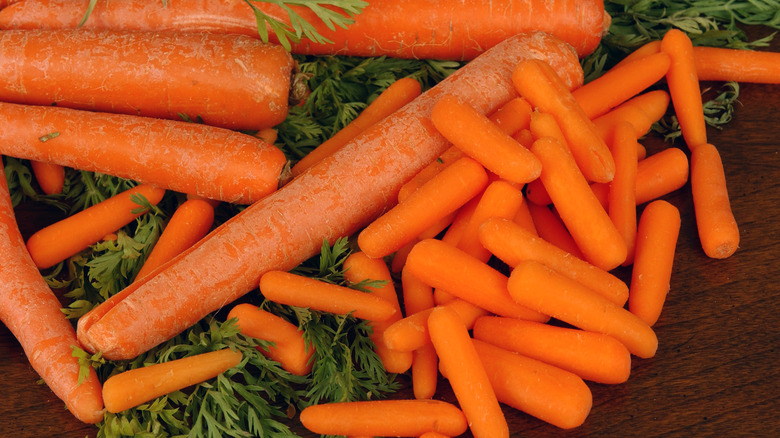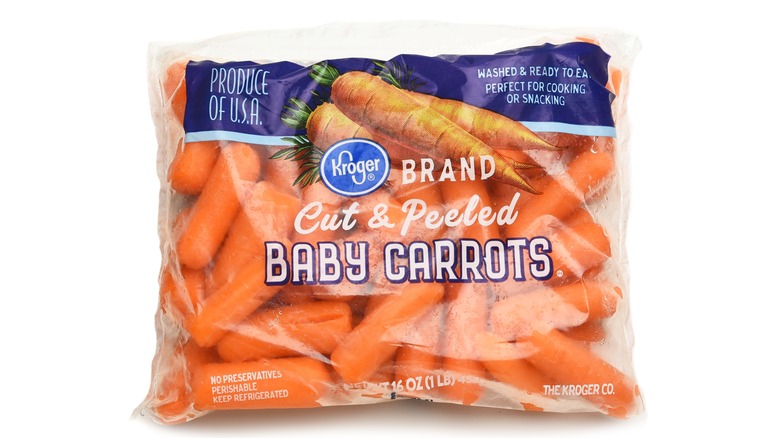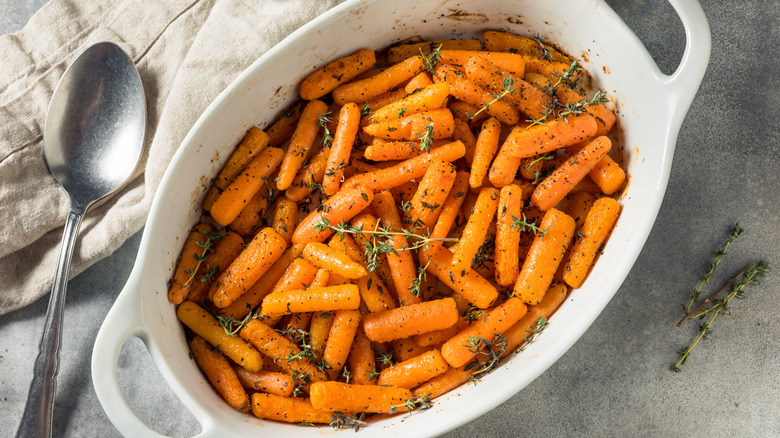What The White Blush On Baby Carrots Really Means
The hummus is out, and you are ready to snack. All you need is something crunchy and fresh. You reach for the bag of baby carrots in your crisper drawer, only to find that each orange piece is covered in dusty white. It kind of looks like mold, or maybe some sort of chemical residue. You lose hope and are ready to toss the whole bag, but actually, there is no need. More than likely, those baby carrots are totally edible, and there's even a way to get rid of that unsightly coating.
The powdery white coating is called white blush, carrot blush, or, charmingly, scuzz, and it is not actually growing on your baby carrots. The carrot is literally drying out, which is common for baby carrots, and the white blush is an indication of that dehydration. It is a common myth that white blush is chlorine residue. Baby carrots are commonly washed in a highly diluted chlorine solution and then rinsed with water. This process helps protect against foodborne illness and is recommended by the Food and Drug Administration. Sometimes carrots that have had some kind of abrasion will develop white markings that come from lignin, a polymer that carrots produce when they undergo stress. If the white blush on your carrots doesn't go away when soaked in water, it could be from lignin, but either way, the carrot is still totally safe to eat.
Why do baby carrots develop white blush more often than regular carrots?
Baby carrots are just filed-down pieces of regular full-grown carrots, not young, small carrots as the name suggests. They were invented by a carrot farmer named Mike Yurosek in 1989. He was tired of wasting damaged or broken carrots. Only about 30% of carrots were considered cosmetically acceptable by supermarkets during that period. Peeling and cutting the misshapen carrots into small uniform cylinders was originally intended as a cooking time-saver. However, customers loved the carrots as an easy snack option. With this new choice, carrot consumption in the United States increased dramatically, and now, around 70% of carrots purchased are baby carrots.
Regular carrots have a natural protective skin. When baby carrots are shaved down, they lose that outside layer. The more delicate inside flesh is exposed to the outside air, making baby carrots much more prone to dehydration — and thus white blush. Producers of baby carrots will often try to combat this by packaging them with a small amount of water.
What to do with baby carrots covered in white blush
There is an easy way to rid baby carrots of white blush — simply soak them in cool water. The thirsty vegetable will absorb the liquid, and the white markings should disappear, regaining some of their former freshness. The main benefit is cosmetic – though rehydrating the baby carrots can also improve the taste. After soaking your baby carrots in water, dry them with a clean paper towel or dish towel. Store baby carrots in the refrigerator in a sealed plastic or glass container wrapped in a paper towel to help them retain moisture and reduce exposure to air. You can also keep baby carrots submerged in water, changing the water every few days.
If you don't want to go through the trouble of soaking your baby carrots, use them for what they were originally invented for — cook them! Throw a handful of baby carrots into a braise, use them as a base for a roasted chicken, or make vegetable stock. You can sautee them whole in a stir-fry or toss a few into a healthy carrot-pineapple smoothie. Carrots can last up to a month in the fridge when stored properly, so even if they are looking a little beat up, as long as they are not visibly rotting, you still have the green light to use them up.



